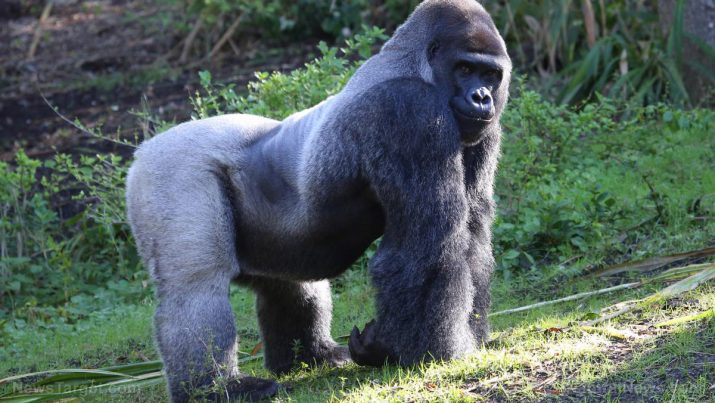
A study of the microbiomes of wild gorillas provides clues to our own health
Tuesday, June 19, 2018 by RJ Jhonson
http://www.naturalnewsresearch.com/2018-06-19-a-study-of-the-microbiomes-of-wild-gorillas-provides-clues-to-our-own-health.html

In a study published in the journal Nature Communications, researchers from the Center for Infection and Immunity (CII) at Columbia University examined the microbiomes of gorillas and chimpanzees. Their findings uncovered significant insights about the evolution of the human microbiome and what it means for human health in general.
The researchers wanted to compare the gut microbes in both gorillas and chimpanzees with other primates, including humans. What they found was that the microbiomes in both ape species fluctuated along with changes in seasonal rainfall.
The scientists believed that shifting seasons helped dictate the animals’ diet by varying what food was accessible. For instance, the animals altered their usual fiber-rich diet in time for summer when succulent fruits became more abundant. Naturally, this resulted in changes in the animals’ predominant microbiome population.
“We observed dramatic changes in the gorilla and chimpanzee microbiomes depending on seasons and what they are eating,” senior author Dr. Brent L. Williams, assistant professor of Epidemiology at CII said. “Bacteria that help gorillas break down fibrous plants are replaced once a year by another group of bacteria that feed on the mucous layer in their gut during the months they are eating fruits.”
The findings were notably similar to what was observed among members of Tanzania’s Hadza hunter-gatherers who also depended on seasonal food items available in their environment. The same cannot be said, however, for people who live in industrialized areas, such as in many U.S. cities.
For people who live in urban areas where food supply is generally unchanged throughout the seasons, fluctuations in microbiomes may not occur as much. The scientists believe that their studies, as well as similar undertakings, could reveal the essential role that gut bacteria play in human health and the risk of disease.
“The fact that our microbiomes are so different from our nearest living evolutionary relatives says something about how much we’ve changed our diets, consuming more protein and animal fat at the expense of fiber,” noted Williams. “Many humans may be living in a constant state of fiber deficiency. Such a state may be promoting the growth of bacteria that degrade our protective mucous layer, which may have implications for intestinal inflammation, even colon cancer.” (Related: Healthy gut bacteria help body regrow intestinal cells, surprised researchers discover.)
How to care for the microbiome
The human gut is home to millions of microorganisms, but not all of them are bad. In fact, some of them are essential for proper digestion and good health. These microscopic tenants are often called “friendly” or “good” gut bacteria.
Many studies have shown links between gut bacteria populations and the emergence – or absence – of health conditions. For example, the presence of some bacteria is known to reduce the risk of obesity and diabetes.
Adopting a few simple habits can keep the population of friendly gut bacteria higher than that of their less benign counterparts, which are also found in the stomach. This is essential to ensuring that one reaps the health advantages offer.
- Eating food items that rich in fiber – Vegetables, especially bean and legumes, and fruits are some of the best sources of fiber. They even come with nutrients crucial to healthy body function.
- Consuming fermented foods – Fermented food items have had their composition altered by bacteria. They are rich in probiotics or good bacteria that aid in digestion and help maintain the body’s health. These include kimchi, yogurt, and sauerkraut.
- Taking prebiotic supplements – Prebiotics are substances that the body cannot readily digest, but serve as food to the bacteria that live in the intestines. Prebiotic supplements feed these bacteria and keep their populations high.
Get the latest science news on animals, humanity, and nature at Discoveries.news.
Sources include:
Tagged Under: Tags: chimpanzees, chimps, friendly gut bacteria, good bacteria, gorillas, gut bacteria, microbiome, microorganisms, proper digestion, research





